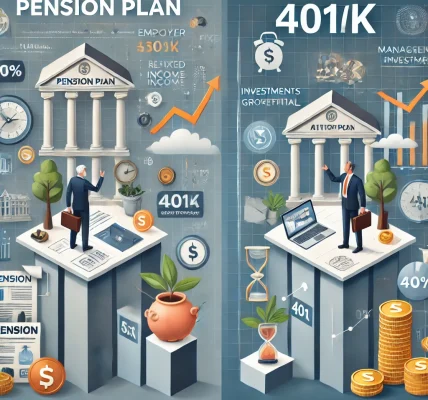Introduction
Market fluctuations are an unavoidable reality of investing. Whether you are years away from retirement or already living off your savings, stock market volatility can significantly impact your retirement funds. Economic downturns, inflation, and sudden market crashes can erode savings, while strong bull markets can increase wealth.
This article will explore how market fluctuations impact retirement savings and provide actionable strategies to minimize risks, maintain financial stability, and ensure a secure retirement, even in uncertain economic conditions.
1. Understanding Market Fluctuations
Market fluctuations refer to the constant rise and fall of asset prices due to economic conditions, geopolitical events, investor sentiment, and corporate performance. These fluctuations occur in cycles, with periods of growth (bull markets) and downturns (bear markets).
✅ Bull Markets – Stock prices rise, investments grow, and retirement portfolios increase in value. ✅ Bear Markets – Stock prices decline, reducing portfolio value and affecting retirement savings. ✅ Corrections & Recessions – Short-term market corrections (10% declines) and long-term recessions can significantly impact investments.
A diversified retirement portfolio can help mitigate the impact of these fluctuations.
2. How Market Fluctuations Affect Retirement Savings
a) Portfolio Value Volatility
Market downturns can reduce the overall value of retirement investments, affecting savings meant for post-retirement years.
b) Sequence of Returns Risk
If withdrawals are made during a market downturn, portfolio longevity is threatened. Retirees drawing income during a bear market risk depleting their funds faster.
c) Inflation’s Role
Rising inflation erodes purchasing power, making fixed-income investments and savings worth less over time.
d) Interest Rate Changes
Bond yields and interest rates impact investment returns. Low-interest rates may reduce retirement income for bond-heavy portfolios.
3. Strategies to Protect Your Retirement Savings from Market Volatility
a) Diversification: Spread Your Risk
Investing in a mix of assets reduces risk exposure.
✅ Stocks for Growth – Long-term appreciation and wealth accumulation. ✅ Bonds for Stability – Provide steady income with lower risk. ✅ Real Estate & Alternative Investments – Offer inflation protection. ✅ Cash & Liquid Assets – Maintain liquidity for emergencies.
b) Dollar-Cost Averaging
Investing consistently, regardless of market conditions, reduces the impact of volatility over time. Buying more shares when prices are low and fewer when they are high averages out investment costs.
c) Asset Allocation & Rebalancing
Adjusting asset allocation based on age, risk tolerance, and market conditions can optimize returns while reducing risk.
✅ Younger investors: More stocks, fewer bonds. ✅ Near retirement: Shift towards stable, low-risk investments. ✅ Post-retirement: Focus on income-generating assets.
d) Emergency Fund: A Safety Net
Maintaining an emergency fund (6–12 months of expenses) prevents unnecessary withdrawals during market downturns.
e) Delay Withdrawals During Market Downturns
If possible, retirees should avoid withdrawing from retirement accounts when the market is down, allowing investments time to recover.
f) Utilize Safe Withdrawal Strategies
A common rule is the 4% withdrawal rate, adjusting based on market conditions. Other strategies include:
📌 Dynamic Withdrawal Strategy – Reducing withdrawals in downturns. 📌 Bucket Strategy – Separating assets into short-, mid-, and long-term investments. 📌 Annuities – Providing a guaranteed lifetime income source.
4. Leveraging Tax-Advantaged Accounts
Utilizing tax-advantaged retirement accounts ensures optimized savings growth while minimizing tax burdens.
✅ 401(k) & Roth 401(k) – Employer-sponsored plans with tax benefits. ✅ IRA & Roth IRA – Tax-free growth and withdrawals in retirement. ✅ Health Savings Account (HSA) – Tax-free medical expense savings.
Strategic withdrawals from tax-deferred and tax-free accounts can help mitigate losses during downturns.
5. Understanding Behavioral Finance & Emotional Investing
Market volatility often triggers emotional reactions like panic-selling or overbuying during rallies.
🚫 Common Mistakes to Avoid: ✅ Panic-selling in a downturn. ✅ Timing the market (rarely successful long-term). ✅ Ignoring long-term investment strategies. ✅ Overconcentration in risky assets.
Instead, stay disciplined, follow a long-term strategy, and seek professional financial advice when needed.
6. Adjusting Retirement Plans in Response to Market Conditions
If market downturns impact savings, consider the following adjustments:
📌 Delaying Retirement – Working longer can increase savings and delay withdrawals. 📌 Part-Time Work or Passive Income – Generating additional income reduces reliance on retirement accounts. 📌 Downsizing & Lifestyle Adjustments – Lowering living expenses can help stretch savings further. 📌 Social Security Optimization – Delaying Social Security benefits increases payouts over time.
7. Working with a Financial Advisor
A certified financial planner (CFP) can help: ✅ Develop personalized asset allocation strategies. ✅ Optimize tax-efficient withdrawals. ✅ Rebalance portfolios to match risk tolerance. ✅ Provide emotional discipline during market fluctuations.
Conclusion
Market fluctuations are inevitable, but they don’t have to derail your retirement plans. By diversifying investments, maintaining a long-term perspective, utilizing tax-advantaged accounts, and implementing smart withdrawal strategies, you can protect your retirement savings while continuing to build wealth.
Planning ahead and making informed decisions ensures financial security, allowing you to enjoy retirement with confidence—regardless of market ups and downs. Start today and secure a worry-free retirement future! 🚀




